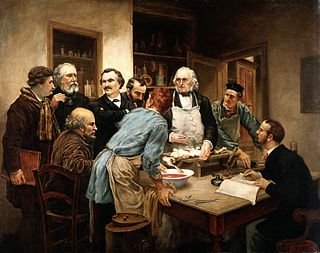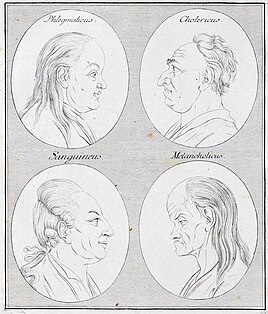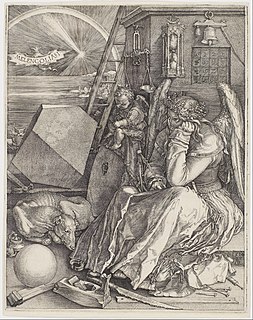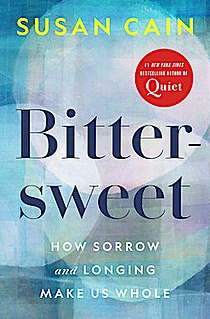Plot summary
The story begins with Parry's younger self being whisked away from his bed and his family in the dead of night and loaded into a van occupied with others in the same situation. From there the story continues in Thorpe Hall, a place best described as a hostel for those yet to be arranged into their defining humor. Whilst staying at the Hall, the protagonist and his young companions begin to learn of their fate and of the 'Rearrangement'. Following a short time in the hall, the four humors are explained to the children, Sanguine, Phlegmatic, Choleric and Melancholic.
Shortly after, the protagonist is taken to see Mr. Reek, one of the teachers at Thorpe Hall. He is told that he will be moved to a new location where he will be integrated into a new family suited to a person of his type. He is also given his name, Thomas Parry, which is used for the majority of the remaining story. After a time, Thomas is transported via train to his new home where he meets his new father and sister, Victor and Marie Parry. During the remainder of his childhood, Thomas settles into his new environment easily, adopting the Sanguine attitude and persona.
With his childhood drawing to a close, Thomas goes to attend University witnessing the slow deterioration of his adopted family as life after the rearrangement which took their mother/wife away from them wears them down. Towards the end of his time at university, Thomas is approached by Diana Bilal, an employee of the ministry of health and social security. She informs Thomas that he had been watched for some time and were interested in employing him as a trainee assessment officer. Thomas is initially reluctant to take her up on the offer, knowing that his adopted family would be disappointed as it was the ministry who they blamed for the loss of their mother and wife. Thomas is won over and accepts the job when Diana tells him that his family need not know of his true occupation and that they would be granted immunity from ever being rearranged again.
Shortly after joining the Ministry, Thomas gets his first experience of participating in a rearrangement when a young girl is to be moved from sanguine territory (the red quarter) to choleric (the yellow quarter). During his time as an observer to the rearrangement, he gets his first view of a border gate, a complex of high concrete walls, barbed wire and minefields patrolled by border guards.
After gaining his first view of the 'nuts and bolts' of the job, Thomas is visited by the head of the ministry of relocation Mr. Vishram. Upon being asked if he was available for lunch, Thomas agrees to meet the man the following day when Vishram would reveal Thomas's next job. The next day, Vishram takes Thomas to a small restaurant in the heart of the red light district to discuss an upcoming conference that Thomas would be attending. It is revealed that the conference was to be held in the Blue quarter. Realizing the chance to discover something entirely new and exciting, Thomas duly accepts.
A few days later, Thomas finds himself stepping off of a train and into the Blue quarter, typified by its many canal systems that weave their way through the metropolis. As he walks through the city to get to his hotel, he is stopped by a man who forces a small leaflet into his hand saying you may find this interesting. Thomas then goes to the Sheraton and later meets Walter Ming, a mysterious character who asks Thomas if he's going to the "Bathysphere", which appears at first to be a club. Thomas then goes to the Bathysphere and a very confusing scene occurs. Thomas opens a pale gold door and suddenly he has a flashback of his entire life. After these flashbacks, his view of the Divided Kingdom has changed.
The guests attending the conference at the Blue Quarter are moved into the Yellow Quarter for reasons that are not quite clear, possibly because it is Rearrangement Day. During the night a bomb goes off in the hotel and Thomas escapes determined to go back to the Bathysphere.
Fire is one of the four classical elements along with Earth, Water and Air in ancient Greek philosophy and science. Fire is considered to be both hot and dry and, according to Plato, is associated with the tetrahedron.

Melancholia or melancholy is a concept found throughout ancient, medieval and premodern medicine in Europe that describes a condition characterized by markedly depressed mood, bodily complaints, and sometimes hallucinations and delusions.

Physiology is the scientific study of functions and mechanisms in a living system. As a sub-discipline of biology, physiology focuses on how organisms, organ systems, individual organs, cells, and biomolecules carry out the chemical and physical functions in a living system. According to the classes of organisms, the field can be divided into medical physiology, animal physiology, plant physiology, cell physiology, and comparative physiology.

The four temperament theory is a proto-psychological theory which suggests that there are four fundamental personality types: sanguine, choleric, melancholic, and phlegmatic. Most formulations include the possibility of mixtures among the types where an individual's personality types overlap and they share two or more temperaments. Greek physician Hippocrates described the four temperaments as part of the ancient medical concept of humourism, that four bodily fluids affect human personality traits and behaviours. Modern medical science does not define a fixed relationship between internal secretions and personality, although some psychological personality type systems use categories similar to the Greek temperaments.
Phlegm is mucus produced by the respiratory system, excluding that produced by the nasal passages. It often refers to respiratory mucus expelled by coughing, otherwise known as sputum. Phlegm, and mucus as a whole, is in essence a water-based gel consisting of glycoproteins, immunoglobulins, lipids and other substances. Its composition varies depending on climate, genetics, and state of the immune system. Its color can vary from transparent to pale or dark yellow and green, from light to dark brown, and even to dark grey depending on the constituents. The body naturally produces about 1 quart of phlegm every day to capture and clear substances in the air and bacteria from the nose and throat.

Humorism, the humoral theory, or humoralism, was a system of medicine detailing a supposed makeup and workings of the human body, adopted by Ancient Greek and Roman physicians and philosophers.

Arousal is the physiological and psychological state of being awoken or of sense organs stimulated to a point of perception. It involves activation of the ascending reticular activating system (ARAS) in the brain, which mediates wakefulness, the autonomic nervous system, and the endocrine system, leading to increased heart rate and blood pressure and a condition of sensory alertness, desire, mobility, and readiness to respond.

Thérèse Raquin[teʁɛz ʁakɛ̃] is an 1868 novel by French writer Émile Zola, first published in serial form in the literary magazine L'Artiste in 1867. It was Zola's third novel, though the first to earn wide fame. The novel's adultery and murder were considered scandalous and famously described as "putrid" in a review in the newspaper Le Figaro.

Observations on the Feeling of the Beautiful and Sublime is a 1764 book by Immanuel Kant.

Complexion in humans is the natural color, texture, and appearance of the skin, especially on the face.

Christ Crowned with Thorns, sometimes known as Christ Mocked, is an oil on panel painting by Hieronymus Bosch. It is now in the National Gallery in London, which dates it to around 1510, though some art historians prefer earlier dates.
Wil Cwac Cwac is a Welsh language television cartoon created in 1982, based on a series of children's books written in the early 1930s by Jennie Thomas and J. O. Williams. Both book and cartoon series take place in rural Wales. The Welsh-language series was produced by Siriol Animation for S4C. An English-language version of the show was produced for the wider English-speaking market. The first 20 episodes were dubbed in British English and aired on Children's ITV in 1984, with the remaining 10 following in 1986. In both versions, all narration and characters were voiced by Myfanwy Talog. An American English dub was also made, with Liza Ross narrating. This version aired in the United States on The Disney Channel as a segment on the program Lunch Box.
Symphony No. 2 De fire Temperamenter, "The Four Temperaments", Op. 16, FS 29 is the second symphony by Danish composer Carl Nielsen, written in 1901–1902 and dedicated to Ferruccio Busoni. It was first performed on 1 December 1902 for the Danish Concert Association, with Nielsen himself conducting. As indicated in the subtitle, each of its four movements is a musical sketch of a humor of the four temperaments: choleric, phlegmatic, melancholic, and sanguine. Despite its apparent concept of program music, the work is a fully integrated symphony in traditional symphonic structure.
The two-factor model of personality is a widely used psychological factor analysis measurement of personality, behavior and temperament. It most often consists of a matrix measuring the factor of introversion and extroversion with some form of people versus task orientation.

The Four Temperaments or Theme and Four Variations is an orchestral work and ballet by Paul Hindemith. Although it was originally conceived as a ballet for Léonide Massine, the score was ultimately completed as a commission for George Balanchine, who subsequently choreographed it as a neoclassical ballet based on the theory of the four temperaments.

Melencolia I is a large 1514 engraving by the German Renaissance artist Albrecht Dürer. The print's central subject is an enigmatic and gloomy winged female figure thought to be a personification of melancholia – melancholy. Holding her head in her hand, she stares past the busy scene in front of her. The area is strewn with symbols and tools associated with craft and carpentry, including an hourglass, weighing scales, a hand plane, a claw hammer, and a saw. Other objects relate to alchemy, geometry or numerology. Behind the figure is a structure with an embedded magic square, and a ladder leading beyond the frame. The sky contains a rainbow, a comet or planet, and a bat-like creature bearing the text that has become the print's title.

Iranian traditional medicine (ITM), also known as Persian traditional medicine, is one of the most ancient forms of traditional medicine.
Florence Littauer was an American Christian self-help author and public speaker. Littauer is best known for her series of books based upon the Personality Plus personality system. She was listed as one of Helen K. Hosier's "100 Christian Women Who Changed the Twentieth Century" and has received the National Speakers Association's Council of Peers Award for Excellence and has been designated by them as a Certified Speaking Professional.
Modern understanding of disease is very different from the way it was understood in ancient Greece and Rome. The way modern physicians approach healing of the sick differs greatly from the methods used by early general healers or elite physicians like Hippocrates or Galen. In modern medicine, the understanding of disease stems from the "germ theory of disease", a concept that emerged in the second half of the 19th century, such that a disease is the result of an invasion of a micro-organism into a living host. Therefore, when a person becomes ill, modern treatments "target" the specific pathogen or bacterium in order to "beat" or "kill" the disease.

Bittersweet: How Sorrow and Longing Make Us Whole is a 2022 book written by American author Susan Cain.













